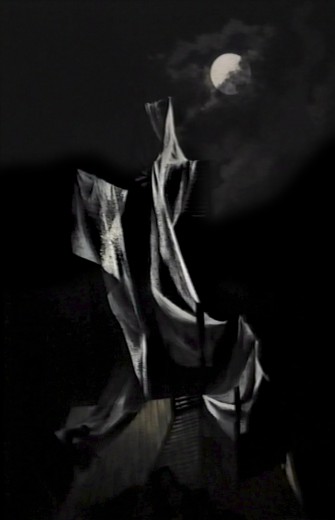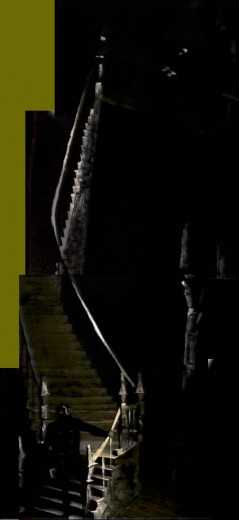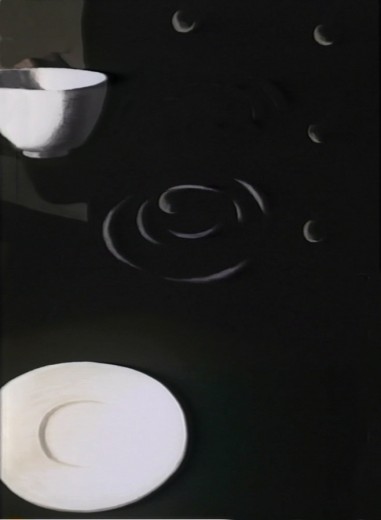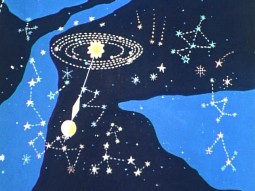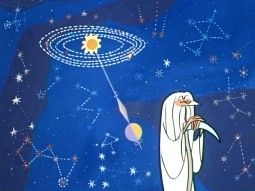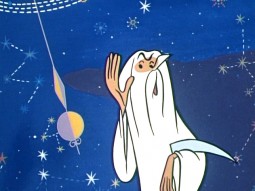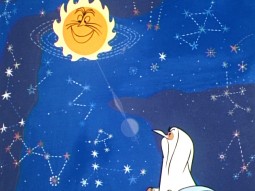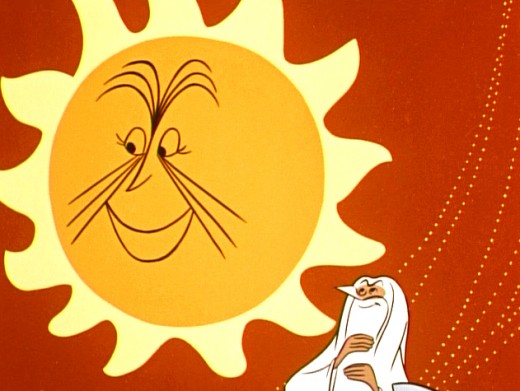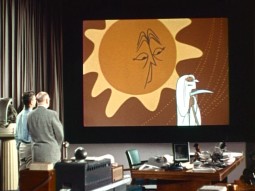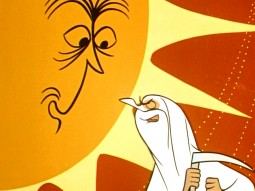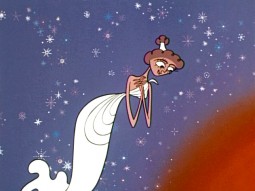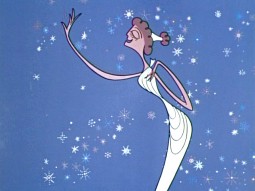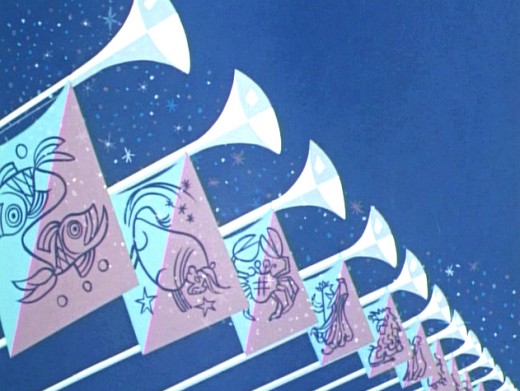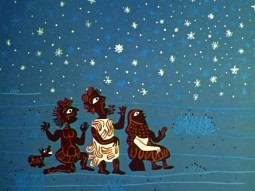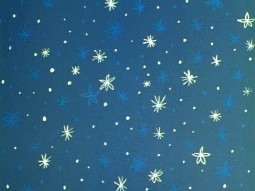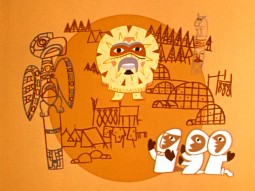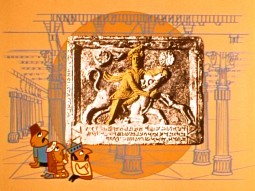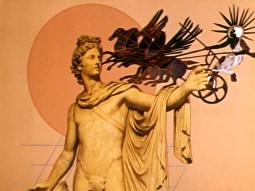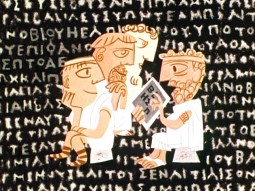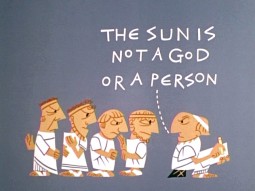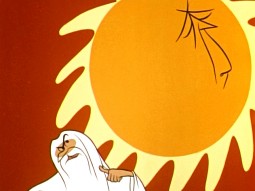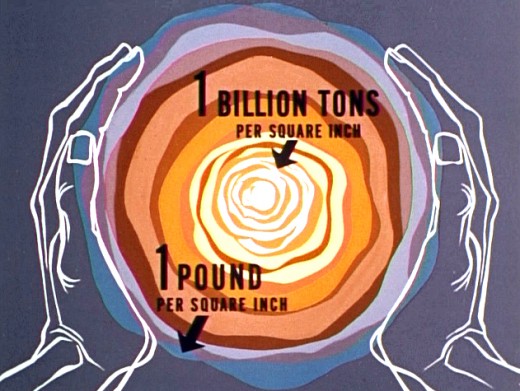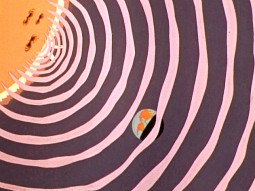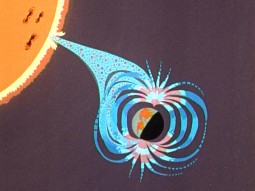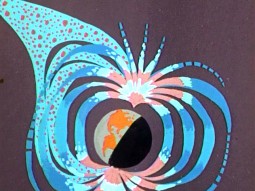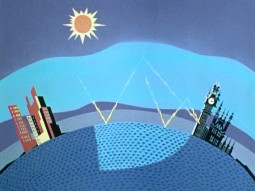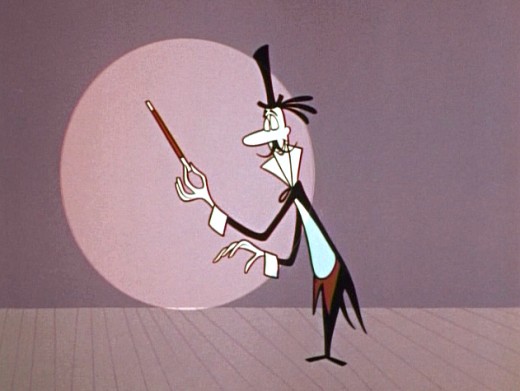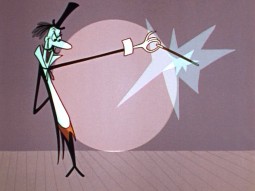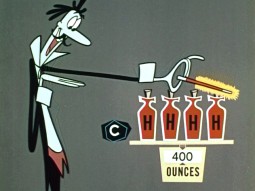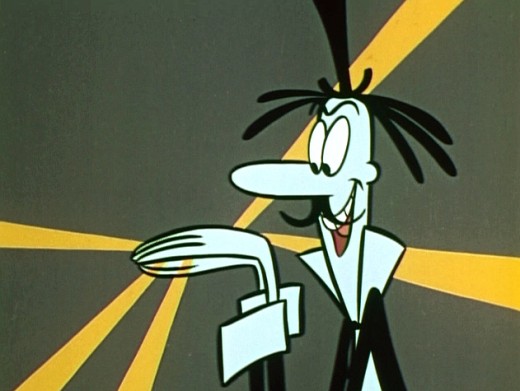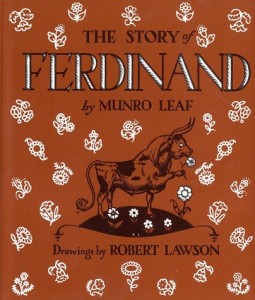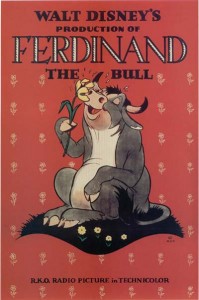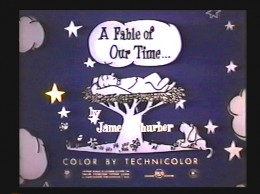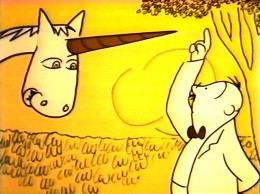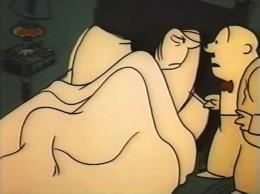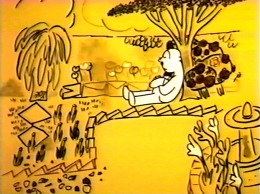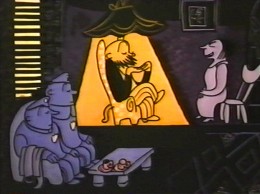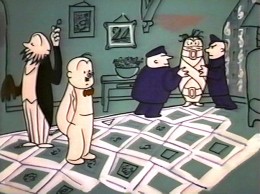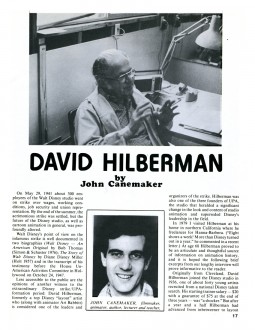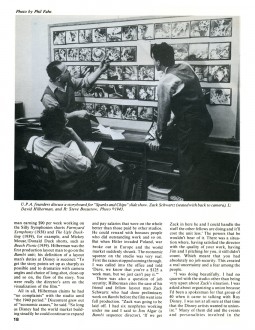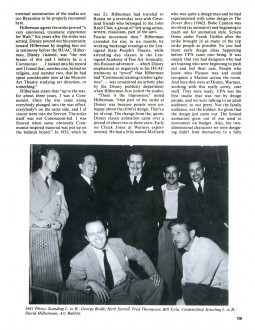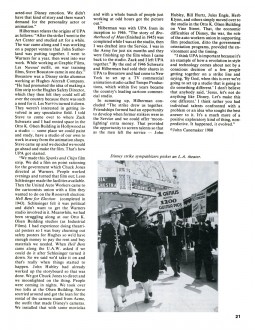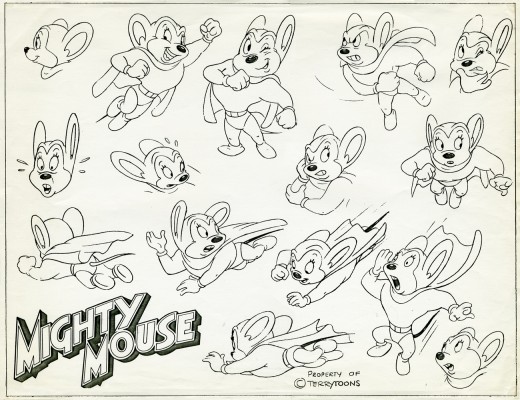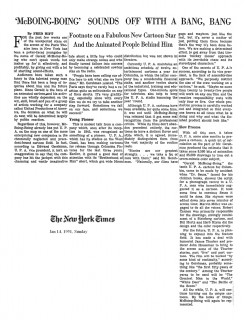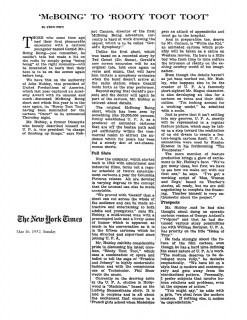Category ArchiveUPA
Animation Artifacts &UPA 29 Dec 2007 08:34 am
The Tell Tale Heart – part 2
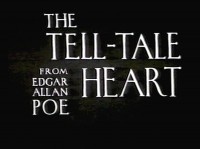 - Today I complete the collection of frame grabs I’ve pulled from UPA’s The Tell Tale Heart. If you don’t have the film on dvd, watch it on YouTube. This film is included among the films preserved in the U S National Film Registry.
- Today I complete the collection of frame grabs I’ve pulled from UPA’s The Tell Tale Heart. If you don’t have the film on dvd, watch it on YouTube. This film is included among the films preserved in the U S National Film Registry.
However, to quote John Kricfalusi, “‘Masterpiece’?? It’s a total boring slow eyesore.” By that, I assume he means the film doesn’t scream at you; it tells a story, and I guess that makes it boring. The fact that the cartoon lifted the Production Designer to the height of this storytelling process is irrelevant. Perhaps, today’s audiences are too impatient. (I once had an intern tell me that she couldn’t watch Citizen Kane because it was too boring. It was in Black and White.)
Regardless, I have to step off of my soapbox; here are the remainder of these beautiful images. I hope they inspire someone the way they once did me when I first saw the film. I offer these up to Paul Julian, who did such brilliant work of design.
-
-
-
-
-
-
-
-
-
Then it was over.
The heart was still.
The eye was dead.
I was free.
_______________________________________________________________________________
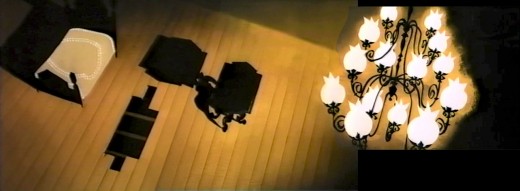
But there was still work to be done.

I replaced the planks so carefully no eye . . . not even his
could have found anything wrong.

So soon?
“The neighbors reported a scream. We’re obliged to investigate.”
“A scream? My own, gentlemen. A childish dream.”

“But come in, please. You’ll want to look through the house.”
“That is our duty. Where is the old man?”
“Gone to the city.”

“You’re up very early.”
“The dream I spoke of. It awakened me.”
-
-
-
-
-
-
-
-
-
“When did he leave?”
“The old man? Yesterday.”
“How long will he be away?”
Tw . . . two weeks.”
-
-
-
-
________________________

“Perhaps longer.”
“Nothing out of place, here.”
“There is his bed, his cupboard. All in order?”
“Quite in order.”
“All quite in order.”
“Nothing amiss. You understand that when a complaint is made we have no choice but . . .”
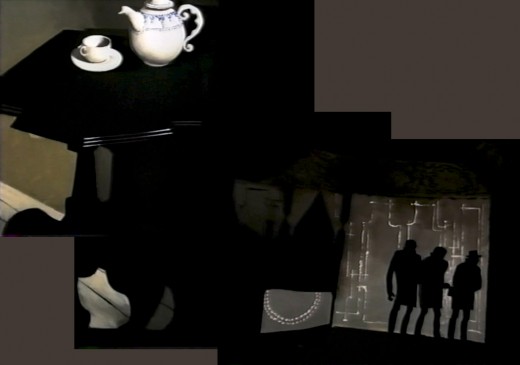
“Stay! It’s such a wretched hour. I was making tea. A hot drink will break the chill.”
“Surely it will surprise such good people how much the night . . .”
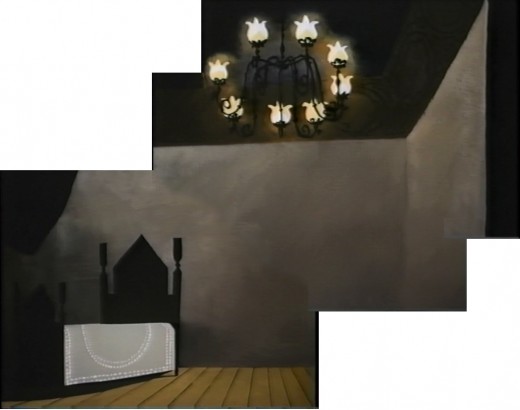
“. . .conceals from their eyes. But not yours, to be sure.”
CRASH !
“What? What did you say good sir?

“Yes. Yes, of course. The hot water. It will do no harm to the bare boards.
I’m a little less tidy with the old man away.”
-
-
-
_
_
_
_
_
_
_
-
Then I heard it. It might have been a hand. A clock.
__________________________________________________________________

But no, louder. Still louder. They must hear it.

But still they talk and talk. They must.

They must. Of course they do. They know. They do. They’re torturing me.
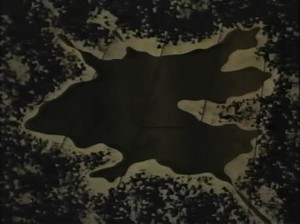
Letting it beat so that I . . . I . . . I
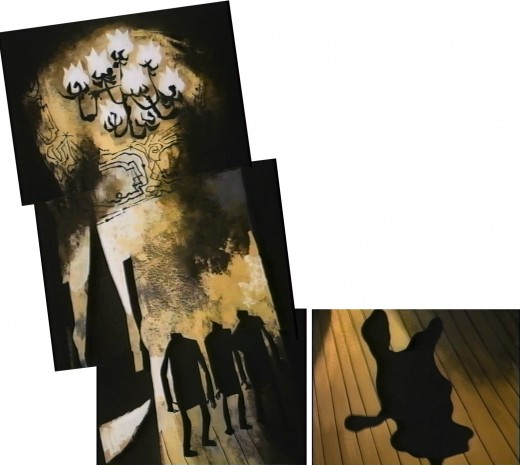
________________________________________STOP IT ! Stop it, you devils !
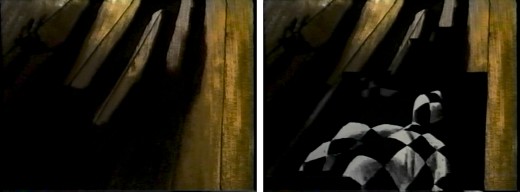
YES ! I did it. It’s there under the floor. OH, STOP IT !
It is the beating of his hideous heart !
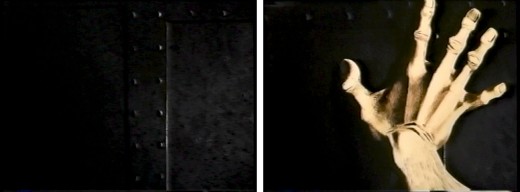
_____________True, I am nervous. Very, very dreadfully nervous.
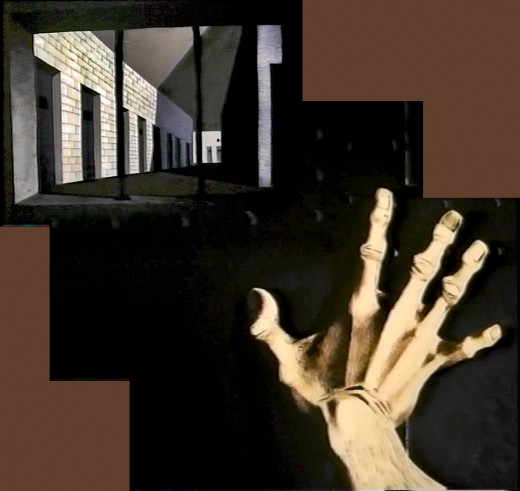
_____________________________________But why will you say that I am mad?
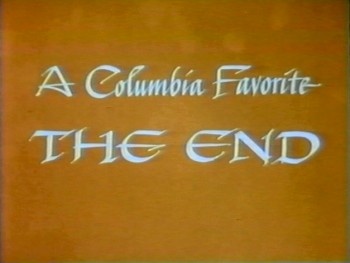
Animation Artifacts &UPA 28 Dec 2007 09:04 am
The Tell Tale Heart – part 1
 - Recently, there have been a number of attacks on the classic
- Recently, there have been a number of attacks on the classic
UPA film, The Tell Tale Heart.
A number of voices – all on blogs
and internet chatter – have called the animation for this film poor. Even recently, in a letter to Michael Barrier, Tee Bosustow writes “about the bad animation in Tell Tale Heart.”
Pat Matthews was the film’s sole credited animator, and he was good, having worked at Fleischer’s and Lantz’ studios before arriving at UPA. His work in this film is exactly what was required of him. Rather, The Tell Tale Heart is a tour de force of production design. It is probably one of the first non-war/propaganda animated films, since Baby Weems, to so feature this element of production over everything else – except story. Paul Julian‘s brilliant artwork oozes from the pores of every frame of this film. Together with James Mason‘s narration and Boris Kremenliev‘s strong musical score, the film evocatively tells the strong Edgar Allan Poe story. This tale has not been told on film any better since it was made in 1953. Ted Parmalee directed the film with authority.
It’s odd how I feel as though I have to defend this movie. I think it a brilliant film and have to remind myself that I’m not alone in believing this. It was nominated for the Oscar and for good reason (it lost to Toot Whistle Plunk and Boom. Ah, the irony!)
Here’s the first of two posts, using frame grabs to feature all of the scenes of the film.
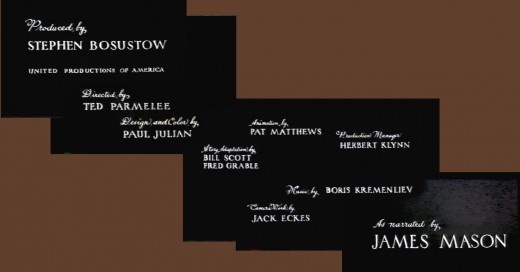
True I’m nervous. Very very dreadfully nervous.

But why will you say that I am mad? See how calmly I tell this story to you. Listen.

It starts with the old man. An old man in an old house. A good man I suppose. He had
never harmed me. I didn’t want his gold. . . if gold there was. Then what was it? I think . . .

I think it was . . . his eye. Yes, that eye . . . the eye.

That. His eye staring. Milky white film. The eye.

Everywhere. Everywhere in everything.

Of course, I had to get rid of the eye.
So I waited. Watched. Waited. I was never so kind to the old man.

I looked after him. Each minute. Each second. And I waited.

But night after night. In the hour of the slowest clock . . . I opened the old man’s door.

The eye was always closed. For seven days, I waited. You think me mad? What mad man would wait . . . could wait so patiently?

So long? In the old house . . . with the old man . . . and the eye.

Then on the eighth night I knew . . . tonight. Still, I waited . . .
. . . while time slowed. Stopped. Ebbed out.

A watch’s hand moved more quickly than mine. Then, what? Yelps.
For an hour, I did not move a muscle. I could feel the earth turn. The eye.
Hear the spider spinning. the grinding crumble of decay.
Then . . . dull and muffled, yet . . . Of course, it was the beating of the old man’s heart.

He knew. So strong for such an old man.
Louder then. And still louder. For all the world to hear. I know.
I had to stop it . . . . . AHHHHHH !

Then it was over.
______________________________________________ To be concluded tomorrow.
Animation &UPA 30 Nov 2007 08:56 am
Our Mr. Sun
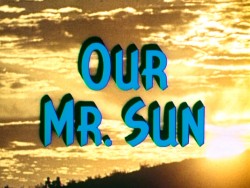 - Back in the 50′s the film director, Frank Capra, produced, directed and wrote four specials for TV which were sponsored by Bell. Our Mr. Sun (1956), Hemo the Magnificent (1957), Unchained Goddess (1958) and The Strange Case of the Cosmic Rays (1957) were devoted to explaining basic science to family home audiences. Capra was educated as an engineer, so he had a lifelong interest in science and he initiated these prorams.
- Back in the 50′s the film director, Frank Capra, produced, directed and wrote four specials for TV which were sponsored by Bell. Our Mr. Sun (1956), Hemo the Magnificent (1957), Unchained Goddess (1958) and The Strange Case of the Cosmic Rays (1957) were devoted to explaining basic science to family home audiences. Capra was educated as an engineer, so he had a lifelong interest in science and he initiated these prorams.
Capra also had a long time interest in animation. He was responsible for securing a distribution contract for Disney with Columbia back in the early 30′s. Animation became a large part of these four programs, and Capra found different animation houses to do them. UPA, Disney, Shamus Culhane‘s studio and WB all were involved.
UPA did the artwork for Our Mr. Sun, the first of these programs. (You can watch it here.) I have a copy of the script marked up by Grim Natwick, so I know he animated on it out of the NY studio of UPA.
The shows play a bit like Ward Kimball‘s “Tomorrowland” episodes of the Disneyland television show. Perhaps these are a bit less joke oriented. The animation is just as limited and design oriented. This format has forever affected many who grew up watching them. Check out the new Pixar 2D piece, You’re The Rat, currently on YouTube (it’ll probably be removed soon.) There’s an obvious link.
Here are some frame grabs from this first show of the Bell Science Series: Our Mr. Sun.
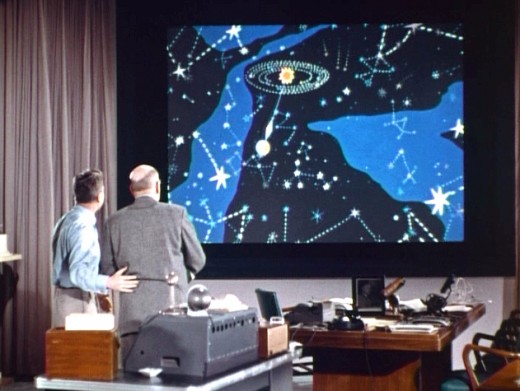
(Cllick any image to enlarge.)
Animation &Commentary &UPA 06 Jun 2007 07:55 am
Unicorns In The Garden
If you think back to how children’s books were adapted in animation prior to the 1950′s, you might think of Ferdinand the Bull by Munro Leaf with illustrations by Robert Lawson. Disney’s oscar winning short followed the story closely but ignored the book’s sensitive illustrations. Disney’s short went so far as to caricature Disney and a number of his animators in the cartoon style of the film.
Or you might think of E.H. Shepard‘s delicate watercolors for Kenneth Grahame‘s book, The Wind In The Willows. This delicacy was completely lost when the Disney artists revised the characters, in a somewhat brash cartoon way, for their film. The same was true of Disney’s adaptation of Shepard’s Reluctant Dragon. Shepard didn’t fare well even into the ’60s when Disney artists adapted his Winnie the Pooh to animation.

There are many other variations on this theme wherein animators completely rework beautiful illustrations of children’s book illustrators and rework stories of the book authors. (For one of the vilest variations look at William Steig’s stunning book, Shrek and compare.)
In 1952, UPA successfully and faithfull adapted Ludwig Bemelman’s book and style of painting to animation. Their film Madeline was a very successful short which was nominated for the Oscar. Almost a year later, UPA decided to adapt James Thurber’s whimsical story, The Unicorn In The Garden, to animation.
Thurber was a New Yorker cartoonist and doodler cum cartoonist. He was enormously successful at his trade, and the book which included “Unicorn In The Garden” was The Thurber Carnival. We know that UPA was considering the entire book of short stories as an animated feature and were calling it Men, Women and Dogs. The feature was scripted. For whatever reason (I’m sure someone out there knows, and I assume it has something to do with Joseph McCarthy), the feature was abandoned, and the short was completed.
They remained absolutely faithful to Thurber’s story and drawing style even though the very short story had only one drawing (and not one of Thurber’s best.) I’ve placed both the story and animated film at the end of this post if you want to compare.
Off the top of my head, I can only think of two other occasions that Thurber’s style was adapted to animation. Both the Jack Lemmon vehicle, The War Between Men and Women, and the tv show, My World and Welcome To It, which starred William Windom, adapted Thurber to animation as an aside to the “cartoonists” featured in the live action. Both were produced by Melville Shavelson and had similar setups – daydreaming cartoonist bumbles through his life with his alter ego being represented by the animation.
The original UPA short, to me, is beautifully animated, designed (around Thurber’s B&W drawing style hence the limited and delicate colors of the film), and sensitive to the original intentions of the author/illustrator. The film story is told with an absolute minimum of dialogue, the animation virtually carries the tale.
I remember seeing this for the first time when I was young and enjoying the seemingly innocent (or is he?) husband as he tries to share his discovery of the Unicorn in their garden with his cynical and sarcastic wife. This wasn’t something I’d seen in animated cartoons before. It wasn’t for children; it was for adults, and I felt like an adult watching it. The film offered a sophistication that Deputy Dawg didn’t. My feelings haven’t changed for the film. I love the psychiatrist who virtually sits his way through the film. Yes, I still absolutely enjoy this film.
The short also set the stage for children’s book adaptations in the future. This is a type work I’ve done often, and I like to think that I’m carrying on the tradition of this film as well as the original Madeline. It’s also something I enjoy doing. I honestly think there’s something that enlarges your own abilities when you can master another’s style and incorporate your own personality into it.
But, of course, that’s all my own opinion.
Here‘s the original story by James Thurber:
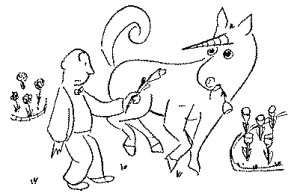 Once upon a sunny morning a man who sat in a breakfast nook looked up from his scrambled eggs to see a white unicorn with a golden horn quietly cropping the roses in the garden. The man went up to the bedroom where his wife was still asleep and woke her. “There’s a unicorn in the garden,” he said. “Eating roses.” She opened one unfriendly eye and looked at him.
Once upon a sunny morning a man who sat in a breakfast nook looked up from his scrambled eggs to see a white unicorn with a golden horn quietly cropping the roses in the garden. The man went up to the bedroom where his wife was still asleep and woke her. “There’s a unicorn in the garden,” he said. “Eating roses.” She opened one unfriendly eye and looked at him.
The original Thurber illustration .
“The unicorn is a mythical beast,” she said, and
turned her back on him. The man walked slowly downstairs and out into the garden. The unicorn was still there; now he was browsing among the tulips. “Here, unicorn,” said the man, and he pulled up a lily and gave it to him. The unicorn ate it gravely. With a high heart, because there was a unicorn in his garden, the man went upstairs and roused his wife again. “The unicorn,” he said,”ate a lily.” His wife sat up in bed and looked at him coldly. “You are a booby,” she said, “and I am going to have you put in the booby-hatch.”
The man, who had never liked the words “booby” and “booby-hatch,” and who liked them even less on a shining morning when there was a unicorn in the garden, thought for a moment. “We’ll see about that,” he said. He walked over to the door. “He has a golden horn in the middle of his forehead,” he told her. Then he went back to the garden to watch the unicorn; but the unicorn had gone away. The man sat down among the roses and went to sleep.
As soon as the husband had gone out of the house, the wife got up and dressed as fast as she could. She was very excited and there was a gloat in her eye. She telephoned the police and she telephoned a psychiatrist; she told them to hurry to her house and bring a strait-jacket. When the police and the psychiatrist arrived they sat down in chairs and looked at her, with great interest.
“My husband,” she said, “saw a unicorn this morning.” The police looked at the psychiatrist and the psychiatrist looked at the police. “He told me it ate a lilly,” she said. The psychiatrist looked at the police and the police looked at the psychiatrist. “He told me it had a golden horn in the middle of its forehead,” she said. At a solemn signal from the psychiatrist, the police leaped from their chairs and seized the wife. They had a hard time subduing her, for she put up a terrific struggle, but they finally subdued her. Just as they got her into the strait-jacket, the husband came back into the house.
“Did you tell your wife you saw a unicorn?” asked the police. “Of course not,” said the husband. “The unicorn is a mythical beast.” “That’s all I wanted to know,” said the psychiatrist. “Take her away. I’m sorry, sir, but your wife is as crazy as a jaybird.”
So they took her away, cursing and screaming, and shut her up in an institution. The husband lived happily ever after.
Moral: Don’t count your boobies until they are hatched.
__________________Now check out the film below if you haven’t seen it recently.
Directed by Bill Hurtz
Story by James Thurber
Animation by Phil Monroe, Rudy Larriva, Tom McDonald
Design & Color by Robert Dranko
Music by David Raksin
Production Manager Herb Klynn
Produced by Stephen Bosustow
Articles on Animation &UPA 05 Jun 2007 08:13 am
Dave Hilberman by John C.
Here’s an excellent article John Canemaker wrote back in 1980. It talks about Dave Hilberman’s involvment in the Disney Strike. Hilberman, of course, was one of the initial founders of UPA with Zach Schwartz. When John Hubley & Phil Eastman came to them with the completed storyboard and the contract for Hell Bent for Election, their studio took off. Eventually, they sold out to Steve Bosustow and opened their own commercial studio in NYC, Tempo.
Thanks to John Canemaker for permission to post this.
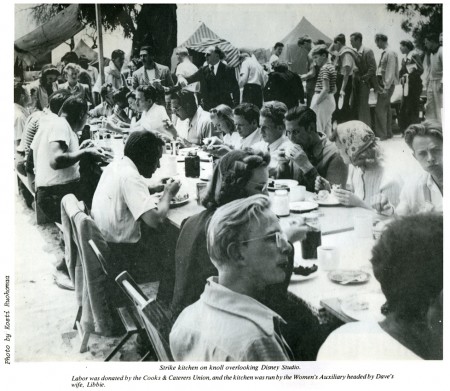 4
4
Animation Artifacts &Story & Storyboards &UPA 04 Jun 2007 07:35 am
OomPahs Storyboard
- I’ve long been a fan of T.Hee‘s work. I think I’ve said that before. When I saw some pages on ebay of the storyboard for The OomPahs, I had to buy them (at a not too expensive price.)
The short was a 1952 UPA film directed by Bobe Cannon. The film’s music score was by Ray Sherman who worked with Ben Pollack’s group, the “Pick-a-rib Boys.”
T. Hee shared the design of the film with Jules Engel who did color work, and the animation was by Roger Daley, Bill Melendez and Frank Smith.
The film is not one of my favorite UPA shorts. I find the style interesting but the story (which to me seems to be a variation of Warner’s I Love To Singa, which was a take on Jolson’s Jazz Singer) is a jazz vs classical music riff. The film seems to talk down to its audience a bit. This was a frequent problem with a number of the UPA films. I find Marvin Miller’s voiceover to be the biggest difficulty in this regard. The voiceover tracks rarely live up to the graphics – though I think the music choices are usually brilliant, despite the low budgets the composers had.
The pages I have obviously are not consecutive in number, but they’re a good sampling.
The first of the pages is a rough version of the second. It’s interesting to see how little varied they are. They are all drawn lightly (I had to darken the linework a slight bit in photoshop), but the rough is even lighter.
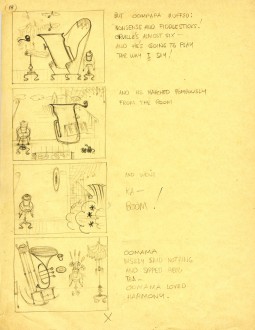 1
1 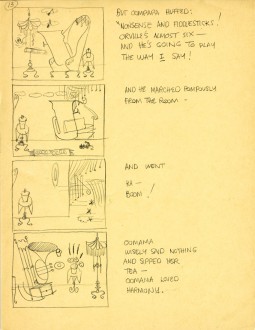 2
2
#1 is a rough version of #2. Both are page 13.
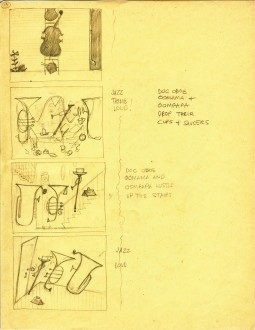 3
3 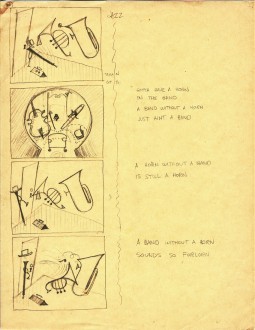 4
4
#3 is a final of pg. 19 & #4 is a final of page 20.
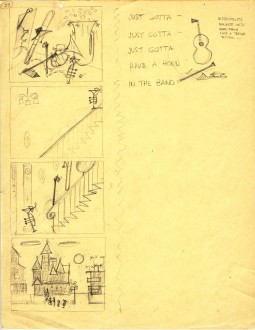 5
5
# is a final of pg. 23.
To see a couple of layout drawings for this short, from Hans Walther‘s collection, go to site here and here.
Animation Artifacts &UPA 23 Apr 2007 08:22 am
Oh, Taurus!
Today, I’m posting a cel Tissa David gave as a gift to Heidi for her birthday in February. It’s time for Taurus, and it’s an appropriate day to post this beautiful cel setup from UPA.
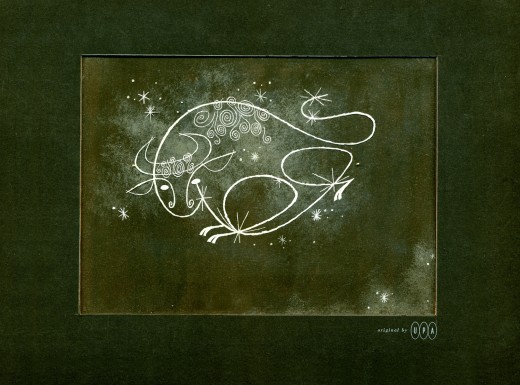
Tissa said she was given the cel shortly after arriving at UPA New York in 1956. Obviously, the image comes from a film done prior to 1956.
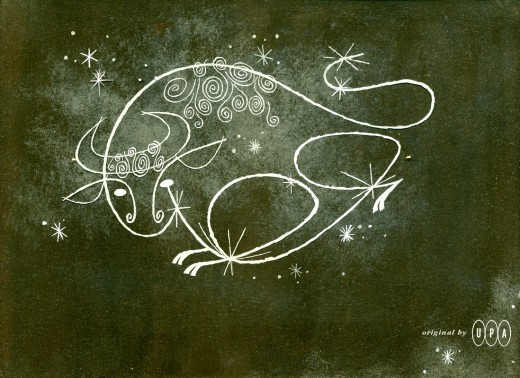
Obviously, I don’t have a clue as to what film it’s from. I thought that it, perhaps, came from one of the shorts done for the McBoing Boing show, but I haven’t been able to locate it. I also thought that perhaps it was done for a commercial.
If anyone out there knows, please check in with me. The first person who comes up with the correct answer will receive a gift from me.
I’m honored to have made Tom Sito‘s memorial blog roll today. What a guy, what a memory!
Animation &Commentary &UPA 25 Feb 2007 09:54 am
There’s So Much Out There
- Mike Barrier had something interesting to say on his site, and this was compounded by Hans Perk‘s response on his site. I’ve thought about it all yesterday into this morning.
Mike pointed out the Hans was posting the Drafts for Pinocchio on his site, A Film LA. Of course, Barrier was pleased about this but wondered how much it was appreciated. He said that he found the response to some Song of the South drafts he’d posted last September
(pg 1, pg 2, pg 3, pg 4, pg 5, pg 6, pg 7, pg 8, pg 9, pg 10) brought little response to it.
The amount of work that goes into scanning and posting these things is enormous, I can assure you, and it’s disappointing when there doesn’t seem to be much of reaction in the community.
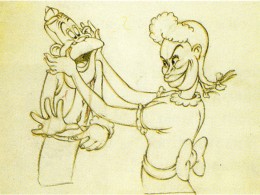 I immediately jumped to Hans’ site to see his response. Hans has been posting many of the Disney Drafts. Everything from Mother Goose Goes Hollywood to The Band Concert to . . . well, Pinocchio.
I immediately jumped to Hans’ site to see his response. Hans has been posting many of the Disney Drafts. Everything from Mother Goose Goes Hollywood to The Band Concert to . . . well, Pinocchio.
Hans pointed out that not only was he disappointed at some of the reaction of these drafts but even more so when he places some of the notes for the Action Analysis classes from the 30′s Disney studio. The silence gets to be deafening. He questioned whether there’s a lack of interest in how to best improve the quality of animation – even in the 3D business – without the knowledge of those who came before us.
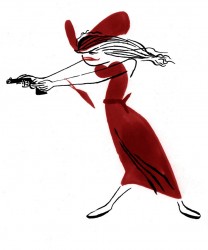 I had an amazing advantage coming along at the time I did and receiving some of the breaks I had. Of course, I wasn’t just searching for a job. This was always going to be my life. Getting a job working for and with my hero, John Hubley, at that developmental stage of my career, allowed me to ask questions and get a significant response. I knew not to bother him about history. (Disney and UPA were sore spots for John, and I stayed clear of the subject. The one time I mentioned it was after seeing Rooty Toot Toot for the first time, and, having been blown away by the film, mentioned it the next morning telling John what an amazing work it was. His response was to say, “Do you think so?” and leave the room. He wanted no conversation about it.)
I had an amazing advantage coming along at the time I did and receiving some of the breaks I had. Of course, I wasn’t just searching for a job. This was always going to be my life. Getting a job working for and with my hero, John Hubley, at that developmental stage of my career, allowed me to ask questions and get a significant response. I knew not to bother him about history. (Disney and UPA were sore spots for John, and I stayed clear of the subject. The one time I mentioned it was after seeing Rooty Toot Toot for the first time, and, having been blown away by the film, mentioned it the next morning telling John what an amazing work it was. His response was to say, “Do you think so?” and leave the room. He wanted no conversation about it.)
(Thanks to Cartoon Modern for this model.)
.
So, I would gather several questions and rework them so that in asking one good question, it would solve several for me. John always gave good answers to every question about the work, and I learned a hell of a lot.
But most people didn’t have access to John Hubley (or, in my career, Tissa David, Dick Williams, Art Babbitt or a dozen other brilliant people.) But there are these lecture notes from the Disney studio. And there are the Drafts where we can study the films, analyze who did what, and really get to know the significant difference between animators.
Mark Mayerson uses Hans’ Drafts to create these brilliant Mosaics on his site. He makes the work easier for us; we don’t even have to look at the film – it’s all layed out for us.
And then these scenes show up on YouTube somewhere else. You don’t even have to buy the films to see many of them. The Drafts Mike Barrier posted for Song of the South immediately turned up on Thad Komorowski‘s Animation ID site. (Disney, of course, removed it for copyright infringement, but it was there as was the opportunity to see it for a short bit.)
Basically, what all this rambling comes down to is that there’s so much out there. There’s so much to learn, and there’s so much opportunity to learn it. I love Tissa David, who I like to call my mentor. She is one of the great animators, trust me, and in her mid eighties she’s still animating. She says that she still has a lot to learn. If she feels that, imagine how I feel. Imagine how we all should feel.
Yet, there’s this incredible new tool out there – the internet. It gives us so much material and with sites like Mike’s and Hans’ and Mark’s and others (like most of those listed to the right of this post) we just have no excuse for all the bad animation out there. Get to work people; we’re all watching.
Hans points out in his commentary, that not publishing pictures probably gets less attention. Hence there are some pictures here.
The Oscars are tonight. I don’t like most of the animation choices.
For animated feature I see only one nominee that’s been animated, Cars. And I wasn’t crazy about that film. The animation was excellent in places, but conceptually the film’s a wreck.
For animated short, I didn’t think most of the films were good, never mind great. I voted for The Danish Poet since it was the only one that really told an adult story. It was a cheap gag or a sophmoric attempt at filmmaking. (Really, students have told many of these same stories without spending the wads of cash on them.) You all know my favorite was Joanna Quinn‘s film. That got my Oscar.
Animation Artifacts &Models &UPA 20 Feb 2007 08:04 am
Random Models
- Did I ever mention that I was a model-sheet Junky? I love them, no matter where they come from or how big they are. I enjoy looking at notes on them, how they were constructed, and signatures. The whole package.
They come in so many sizes, forms and designs.
This is why I get off on a couple of sites that post some beauties. The ASIFA Hollywood Animation Archive has done this frequently, e.g here, here and here.
The Disney Informer also offers quite a few models.
Here are a few from from my collection representing different studios. Of course, I’ll start with Disney, the classics:
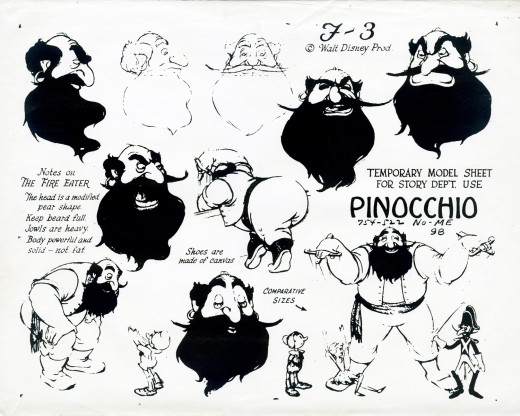
The three models I have are matte photostats, though I believe the handouts were copied onto Disney’s large 5-hole animation paper. On one of these you can see traces of the pegholes.
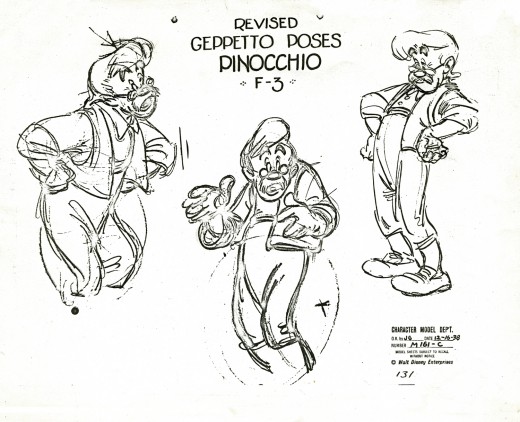
I have a large cel of Gepetto from the pose on the left, hands akimbo. I’m not sure it was ever in the film.
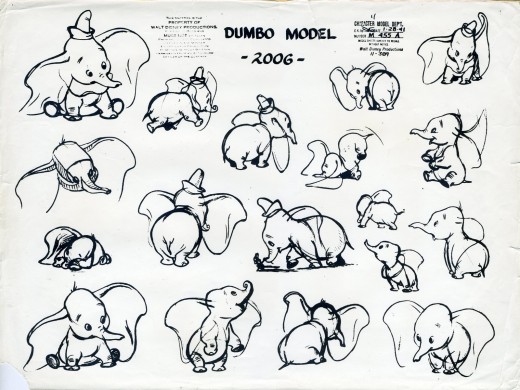
What a beautiful Dumbo. I think I could look at these drawings all day. It’s one of my favorite films. No tricks, no pretensions. Just a great cartoon to make you cry. This is the top of their game.
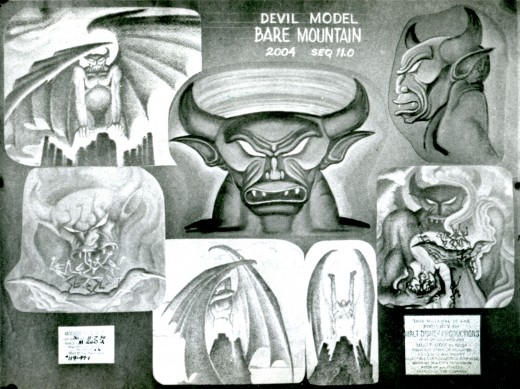
Unfortunately, this one is a photograph I have of the model on a bulletin board. It’s not the best focus.
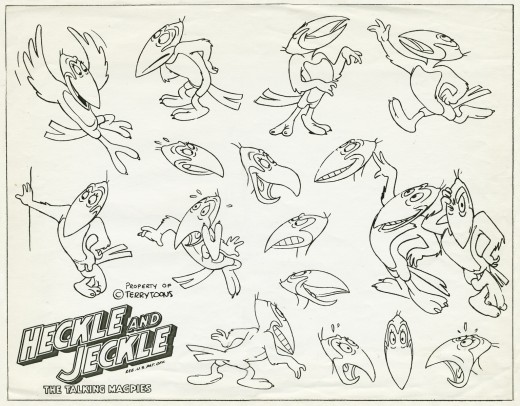
Terrytoons had a beautifully composed model sheet with some fine poses. I wonder how much this helped Jim Tyer. Another Terry model sheet, one of Mighty Mouse, follows. I suspect that Connie Rasinski drew both of them.
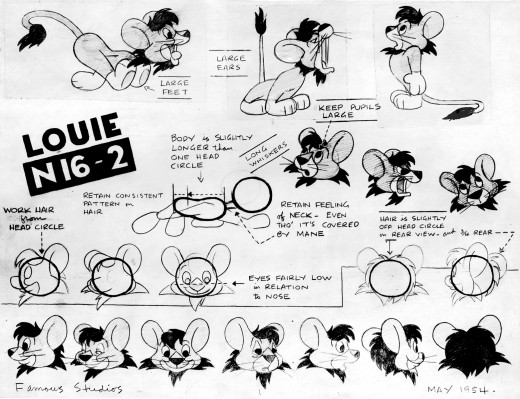
At Paramount, they were a little different. The stats they made, at least those I have, were high gloss. This one has some damage to it where it must’ve gotten wet.
This is the info for this short I found on Dave Mackey‘s invaluable site: Lion In The Roar Rel 12/21/56 – Noveltoon Featuring Louis The Lion, Directed by Seymour Kneitel. Larry Riley drew this model.
I have a couple of the original models which were compiled on animation paper from cut-out drawings. The glue has had a hard time holding up. I gave examples of this last year with an Indian film. See here and here.
The animators received these glossy stats.
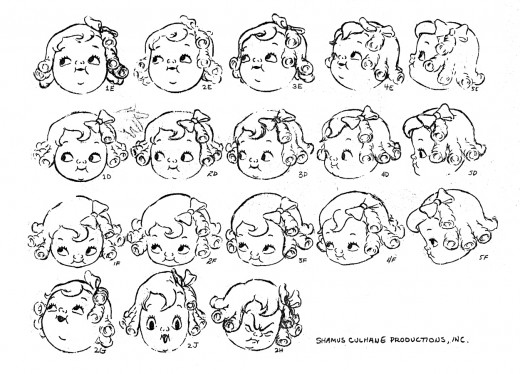
For this Campbell Soup commercial a lot of effort went into drawing the girl. No doubt they were out to please a client. This is the best this character has ever looked.
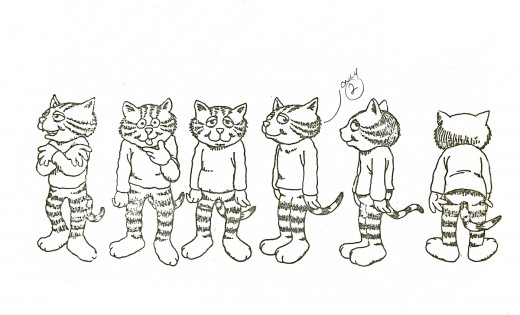
By the time we get to Fritz the Cat, the Xerox machine was in use to make hand-outs for the staff. They didn’t bother with photostats.
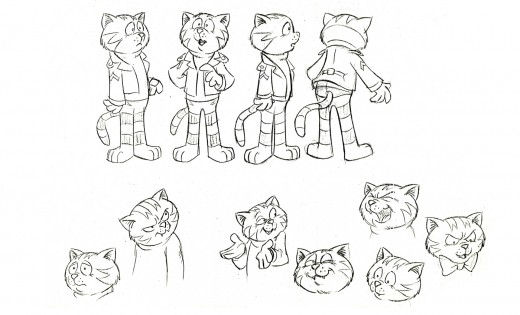
The drawings look like different artists were at work. No wonder the character shifts about on screen. I actually enjoy watching that shift. There’s something alive about it.
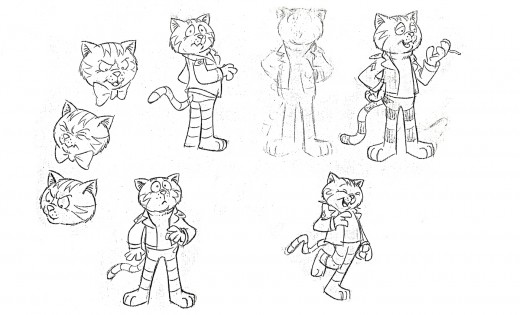
I keep thinking these last two are from The Nine Lives of Fritz the Cat, but I’m sure they came from the original film.
- May I suggest you go to a couple of other sites today, while they’re still fresh. Good work from both of these regular must-read writers.
- Floyd Norman‘s essay over at Jim Hill Media is as great a read to me as anything else he’s written, and I love reading all of his pieces.
- Mark Mayerson has a great piece on his site today whcih certainly got me weathered up. He definitely has some of the most thoughtful, provocative and interesting material on the web.
Animation Artifacts &UPA 24 Sep 2006 12:22 pm
NYTimes & UPA
- I came across a couple of articles I found in the NYTimes and was entertained by them.
The second one (posted & chronologically) was one Grim Natwick had saved and which ended up in my hands.
It’s entertaining in that it reveals an enormous number of feature projects that UPA had planned doing. John Hubley had obviously given an extensive interview in that article which was timed to try to draw as much publicity around the Oscar nomination of Rooty Toot Toot. Toward the end of the article he talks about possible features they were hoping to do. I think this was probably more Hubley’s plan than UPA’s.
A little more digging, and I found I’d had another less interesting article (#1) published a year earlier by the same writer.
